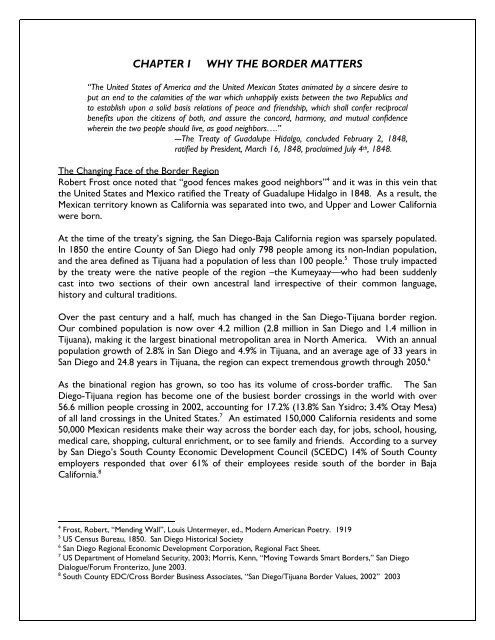Blurred Borders - International Community Foundation
Blurred Borders - International Community Foundation
Blurred Borders - International Community Foundation
Create successful ePaper yourself
Turn your PDF publications into a flip-book with our unique Google optimized e-Paper software.
CHAPTER I WHY THE BORDER MATTERS<br />
“The United States of America and the United Mexican States animated by a sincere desire to<br />
put an end to the calamities of the war which unhappily exists between the two Republics and<br />
to establish upon a solid basis relations of peace and friendship, which shall confer reciprocal<br />
benefits upon the citizens of both, and assure the concord, harmony, and mutual confidence<br />
wherein the two people should live, as good neighbors….”<br />
---The Treaty of Guadalupe Hidalgo, concluded February 2, 1848,<br />
ratified by President, March 16, 1848, proclaimed July 4 th, 1848.<br />
The Changing Face of the Border Region<br />
Robert Frost once noted that “good fences makes good neighbors” 4 and it was in this vein that<br />
the United States and Mexico ratified the Treaty of Guadalupe Hidalgo in 1848. As a result, the<br />
Mexican territory known as California was separated into two, and Upper and Lower California<br />
were born.<br />
At the time of the treaty’s signing, the San Diego-Baja California region was sparsely populated.<br />
In 1850 the entire County of San Diego had only 798 people among its non-Indian population,<br />
and the area defined as Tijuana had a population of less than 100 people. 5 Those truly impacted<br />
by the treaty were the native people of the region –the Kumeyaay—who had been suddenly<br />
cast into two sections of their own ancestral land irrespective of their common language,<br />
history and cultural traditions.<br />
Over the past century and a half, much has changed in the San Diego-Tijuana border region.<br />
Our combined population is now over 4.2 million (2.8 million in San Diego and 1.4 million in<br />
Tijuana), making it the largest binational metropolitan area in North America. With an annual<br />
population growth of 2.8% in San Diego and 4.9% in Tijuana, and an average age of 33 years in<br />
San Diego and 24.8 years in Tijuana, the region can expect tremendous growth through 2050. 6<br />
As the binational region has grown, so too has its volume of cross-border traffic. The San<br />
Diego-Tijuana region has become one of the busiest border crossings in the world with over<br />
56.6 million people crossing in 2002, accounting for 17.2% (13.8% San Ysidro; 3.4% Otay Mesa)<br />
of all land crossings in the United States. 7 An estimated 150,000 California residents and some<br />
50,000 Mexican residents make their way across the border each day, for jobs, school, housing,<br />
medical care, shopping, cultural enrichment, or to see family and friends. According to a survey<br />
by San Diego’s South County Economic Development Council (SCEDC) 14% of South County<br />
employers responded that over 61% of their employees reside south of the border in Baja<br />
California. 8<br />
4<br />
Frost, Robert, “Mending Wall”, Louis Untermeyer, ed., Modern American Poetry. 1919<br />
5<br />
US Census Bureau, 1850. San Diego Historical Society<br />
6<br />
San Diego Regional Economic Development Corporation, Regional Fact Sheet.<br />
7<br />
US Department of Homeland Security, 2003; Morris, Kenn, “Moving Towards Smart <strong>Borders</strong>,” San Diego<br />
Dialogue/Forum Fronterizo, June 2003.<br />
8<br />
South County EDC/Cross Border Business Associates, “San Diego/Tijuana Border Values, 2002” 2003















